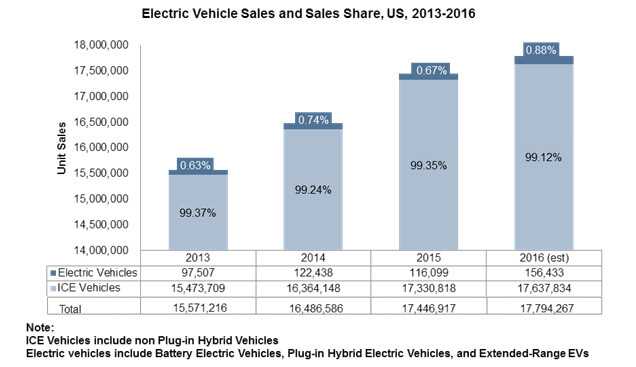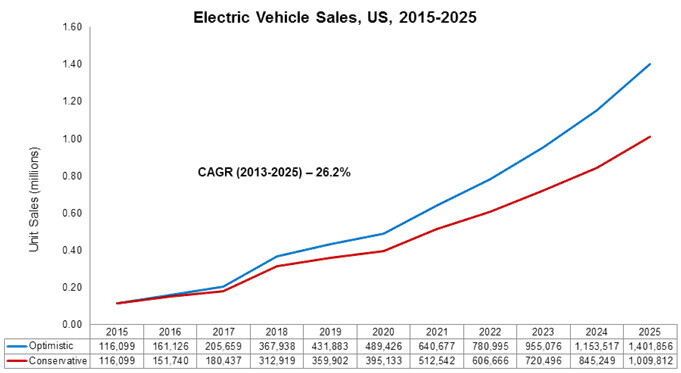Following the United States Department of Energy’s (DOE) first-ever Sustainable Transportation Summit, the Obama Administration on 21 July 2016 announced a slew of actions to accelerate the slow transition to electric mobility. The administration has put together a framework for collaboration for the various stakeholders—including the federal government, vehicle manufacturers, electric vehicle charging companies, electric utilities, and states—to accelerate the deployment of charging infrastructure.
Pushed by the increasingly stringent emission and fuel economy standards, vehicle manufacturers have, and continue to make significant investments in the development of plug-in electric vehicles.
Electric vehicle (EV) sales, however, have been lackluster in recent years, primarily due to their significantly higher price compared to gasoline engine vehicles (about 35%), soft fuel prices, and very limited access to battery charging.

The Obama Administration’s actions are an acknowledgment of the many challenges faced in transitioning to electric mobility, as much as they are a reaffirmation of the administration’s responsibility and commitment to creating conditions for the transition and a self-sustainable electric vehicle market in the long term. The actions will support the administration’s EV Everywhere initiative’s goal of making EVs as affordable and as convenient as conventional internal combustion engine vehicles by 2022.
The announced actions and plans build on the lessons learned from the US DOE funded EV Project for building and studying EV charging infrastructure, and are expected to help electric vehicle adoption in the following ways:
Providing over $4.5 billion in Loan Guarantees to Support the Commercial Scale Deployment of EV Charging Infrastructure
There were over 25 electric vehicle charging infrastructure operators in 2011. Their number is now reduced to 15 because many went out of business. Providing over $4.5 billion in loan guarantees under the Renewable Energy and Efficient Energy (REEE) Projects Solicitation will facilitate commercial borrowing and give infrastructure developers and operators the confidence that their investments are right “bets” for future market value creation and generating long-term returns.
Assuming 100% of loan guarantees are utilized, the initiative will help fund about 90,000 DC fast charging stations. As a reference, Tesla had a total installed base of about 3,000 superchargers in the US in June 2016.
Identifying Corridors for Fast Charging Stations across the United States
The identification of strategic locations for installation of DC fast charging stations is important to ensure their maximum use and ROI as the installation costs are location-dependent and can be as high as $100,000 per charging station.
Working together with the state and local officials through a nomination process, US DOT will designate EV charging corridors with the aim of creating a national charging network. Some feasible corridors though well-known, deployment would take until the end of the decade. By bringing together the different stakeholders, the administration has sought to hasten the decision-making process and remove inter-agency issues and procedural hurdles in implementation.
It won’t be far-fetched to conceive a scenario in future wherein utilities could create a roaming arrangement, similar to the wireless carriers, and provide a convenient coast-to-coast driving ability for EVs.
Aggregated Government Purchase of Electric Vehicles at Discounted Value and Expanding Charging Access at Workplaces and Homes
The administration intends to consolidate the federal, state, county, and municipal government electric vehicle and charging infrastructure purchases to get discounted prices and to reduce the ownership-cost gap of EVs compared to conventional vehicles. The move will also increase access to clean technology, and will help spur demand for electric vehicles.
In 2015, the administration announced plans to cut greenhouse-gas emissions from the government’s 655,000 vehicles to 30% by 2025. By 2020, the federal government will need to include electric vehicles to the extent of 20% of its fleet. The number will rise to 50% by 2025.
Considering that there were 39,044 local governments in the US according to the U.S. Census Bureau (2007), an average purchase of 10 EVs per local government over the next 5 years would generate an additional government demand of about 400,000 vehicles.
The US DOE is also motivating employers to commit to providing EV charging facilities for its employees through the department’s Workplace Charging Challenge. Since its launch in 2013, the Workplace Charging Challenge has grown to more than 350 partners and is expected to meet its goal to partner with 500 US employers by 2018. Considering that vehicles are parked for most of the time at homes or at workplaces, workplace charging facilities will double the EV charging opportunity for commuters and reduce their electric driving range requirement in half. This will significantly improve the utility and value proposition of EVs.
To provide greater access to charging at home, more EV-ready development is being encouraged in cities and states across the US. The federal government introduced an EV-ready building code measure, which in 2018 will become the basis for the International Green Construction Code. Employing EV-ready building practices will enable multi-unit dwelling and commercial building owners and tenants to install charging stations at significantly lower cost.
$50 Million Funding for Battery Technology Advancement with the Aim of Reducing Battery Weight and Cost and Improving Cycle Life
Research on improving battery performance and reducing battery cost will be led by the Pacific Northwest Nation Laboratory (PNNL) as part of the Battery500 research consortium. The consortium will receive an award of $10 million per year for next 5 years to work on reduction of battery weight and cost, and improve its cycle life. The Battery500 Consortium aims to treble the specific energy (to 500 Wh per kg) relative to today’s battery technology and reduce battery cost to less than $100 per kilowatt hour (kWh). Such targeted advancements, combined with advancements and cost reduction in electric motors and power electronics, will lead to EVs achieving near price-parity with internal combustion engines and having an advantage in terms of cost of ownership.
At the targeted performance and price points of Li-ion battery, it has the potential to become the standard energy storage solution for even the internal combustion engine (ICE) vehicles. ICE vehicles currently use valve-regulated lead-acid batteries costing about $120 per kWh (20% more than the targeted Li-ion cost of under $100 per kWh) and having an energy density of 40 Wh per kg (10 times more weight than the target 500 Wh per kg Li-ion battery).
Will this work?
By bringing together industry stakeholders to resolve the inter-stakeholder issues and speed up decision making, providing investment and funding support for advanced research and infrastructure, and committing to replace 50% of the federal light vehicle fleet with EVs by 2025, the government has undertaken significant, and much needed, confidence-building measures to reassure the industry of the long-term viability of investments in electric mobility.
The actions and plans announced by the Obama Administration provide a new vision and framework for collaboration between industry stakeholders. Factoring the positive impact of the Obama Administration’s actions and plans, Frost & Sullivan estimates the 2025 US EV sales to be in the range of 1 to 1.4 million vehicles (5.5% to 7.5% of total light vehicle sales).




